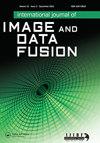近视距环境下蓝牙低能量测距定位精度分析
IF 1.8
Q3 REMOTE SENSING
International Journal of Image and Data Fusion
Pub Date : 2020-05-25
DOI:10.1080/19479832.2020.1752314
引用次数: 4
摘要
针对NLOS环境下蓝牙低能量测距定位精度低的问题,提出了一种基于NLOS蓝牙低能量测距模型的非视距(NLOS)蓝牙低能量测距方法和一种基于TLS方法和三角定位算法的NLOS蓝牙低能量定位算法。首先,根据RSSI值和蓝牙低能信标与终端设备的实际距离建立视距(LOS)蓝牙低能测距模型;其次,基于LOS蓝牙-低能量测距模型和阈值校正后的RSSI峰值,建立了NLOS蓝牙-低能量测距模型;第三,利用NLOS蓝牙-低能量测距模型对NLOS RSSI值进行处理,得到最优测距值。最后,采用NLOS低功耗蓝牙定位算法和最优蓝牙低功耗测距,获得高精度的定位坐标。本文进行了两次实验,实验结果表明:在7 m范围内,改进的NLOS蓝牙低能量测距方法的平均测距精度为0.37 m,比传统方法的结果提高了49.19%。采用本文提出的定位算法,平均定位精度为0.4 m。因此,在NLOS环境下,本文提出的测距方法和定位算法可以显著提高蓝牙低功耗测距定位的精度。本文章由计算机程序翻译,如有差异,请以英文原文为准。
Accuracy analysis of Bluetooth-Low-Energy ranging and positioning in NLOS environment
ABSTRACT Aiming at the low accuracy of Bluetooth-Low-Energy ranging and positioning in NLOS environment, a non-line of sight (NLOS) Bluetooth-Low-Energy ranging method based on the NLOS Bluetooth-Low-Energy ranging model and an NLOS Bluetooth-Low-Energy positioning algorithm based on the TLS method and the triangular positioning algorithm are proposed. Firstly, an line-of-sight (LOS) Bluetooth-Low-Energy ranging model is established by RSSI value and actual distance between the Bluetooth-Low-Energy beacon and the terminal equipment. Secondly, based on the LOS Bluetooth-Low-Energy ranging model and the threshold-corrected RSSI peak, an NLOS Bluetooth-Low-Energy ranging model is established. Thirdly, the NLOS RSSI value is processed by the NLOS Bluetooth-Low-Energy ranging model to obtain the optimal ranging value. Finally, high precision positioning coordinates can be obtained by using NLOS Bluetooth-Low-Energy positioning algorithm and optimal Bluetooth-Low-Energy ranging. In this paper, two experiments are carried out, and the experimental results show that: in the range of 7 m, the average ranging accuracy of the improved NLOS Bluetooth-Low-Energy ranging method is 0.37 m, which is improved 49.19% when compared to the traditional method’s results. The average positioning accuracy is 0.4 m using the positioning algorithm proposed in this paper. Therefore, in NLOS environment, the proposed ranging method and positioning algorithm can significantly improve the accuracy of Bluetooth-Low-Energy ranging and positioning.
求助全文
通过发布文献求助,成功后即可免费获取论文全文。
去求助
来源期刊

International Journal of Image and Data Fusion
REMOTE SENSING-
CiteScore
5.00
自引率
0.00%
发文量
10
期刊介绍:
International Journal of Image and Data Fusion provides a single source of information for all aspects of image and data fusion methodologies, developments, techniques and applications. Image and data fusion techniques are important for combining the many sources of satellite, airborne and ground based imaging systems, and integrating these with other related data sets for enhanced information extraction and decision making. Image and data fusion aims at the integration of multi-sensor, multi-temporal, multi-resolution and multi-platform image data, together with geospatial data, GIS, in-situ, and other statistical data sets for improved information extraction, as well as to increase the reliability of the information. This leads to more accurate information that provides for robust operational performance, i.e. increased confidence, reduced ambiguity and improved classification enabling evidence based management. The journal welcomes original research papers, review papers, shorter letters, technical articles, book reviews and conference reports in all areas of image and data fusion including, but not limited to, the following aspects and topics: • Automatic registration/geometric aspects of fusing images with different spatial, spectral, temporal resolutions; phase information; or acquired in different modes • Pixel, feature and decision level fusion algorithms and methodologies • Data Assimilation: fusing data with models • Multi-source classification and information extraction • Integration of satellite, airborne and terrestrial sensor systems • Fusing temporal data sets for change detection studies (e.g. for Land Cover/Land Use Change studies) • Image and data mining from multi-platform, multi-source, multi-scale, multi-temporal data sets (e.g. geometric information, topological information, statistical information, etc.).
 求助内容:
求助内容: 应助结果提醒方式:
应助结果提醒方式:


